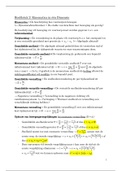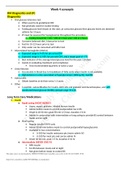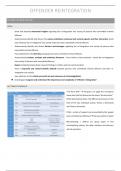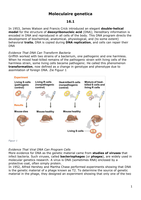Hoofdstuk 2: Kinematica in één Dimensie
Kinematica = De beschrijving hoe voorwerpen bewegen.
(↔ Dynamica/krachtenleer = De studie van krachten met beweging als gevolg.)
De beschrijving v/d beweging v/e voorwerp moet worden gegeven t.o.v. een
referentiestelsel.
Verplaatsing = De verandering in de plaats v/h voorwerp (t.o.v. het startpunt) en
is een vectoriële grootheid met grootte Δ𝑥 = 𝑥2 − 𝑥1 . (↔ Afgelegde afstand)
Gemiddelde snelheid = De afgelegde afstand gedeeld door de verstreken tijd of
het tijdsinterval Δ𝑡, de tijdsperiode waarin we onze waarnemingen doen.
Gemiddelde vectoriële snelheid = De verplaatsing Δ𝑥 gedurende een bepaald
Δ𝑥
tijdsinterval Δ𝑡 → 𝑣 = .
Δ𝑡
Momentane snelheid = De gemiddelde vectoriële snelheid 𝑣 over een
Δ𝑥 𝑑𝑥 𝑑𝑥
infinitesimaal kort tijdsinterval (Δ𝑡 → 0) → 𝑣 = lim = met de afgeleide
Δ𝑡→0 Δ𝑡 𝑑𝑡 𝑑𝑡
van 𝑥 naar 𝑡 → In (x, t)-grafiek is de momentane snelheid de helling oftewel de
richtingscoëfficiënt v/d raaklijn in een bepaald punt.
Gemiddelde versnelling = De snelheidsverandering Δ𝑣 per tijdseenheid Δ𝑡
Δ𝑣
→𝑎= .
Δ𝑡
Gemiddelde vectoriële versnelling = De vectoriële snelheidsverandering Δ𝑣 per
Δ𝑣
tijdseenheid Δ𝑡 → 𝑎 = .
Δ𝑡
→ Negatieve versnelling = Versnelling in de negatieve richting v/h
coördinatensysteem. (↔ Vertraging = Wanneer snelheid en versnelling een
verschillende richting hebben.)
Momentane versnelling = De gemiddelde versnelling 𝑎 over een infinitesimaal
Δ𝑣 𝑑𝑣
kort tijdsinterval (Δ𝑡 → 0) → 𝑎 = lim = .
Δ𝑡→0 Δ𝑡 𝑑𝑡
Opbouw van bewegingsvergelijkingen bij constante versnelling (𝑎 = 𝑎):
Δ𝑥 𝑥−𝑥0 𝑥−𝑥0
- Gemiddelde snelheidsvector 𝑣 = = = of dus 𝑥 = 𝑥0 + 𝑣𝑡.
Δ𝑡 𝑡−𝑡0 𝑡
Δ𝑣 𝑣−𝑣0 𝑣−𝑣0
- Gemiddelde versnellingsvector 𝑎 = = = of dus 𝑣 = 𝑣0 + 𝑎𝑡.
Δ𝑡 𝑡−𝑡0 𝑡
𝑣0 +𝑣
- Snelheid neemt toe met constante versnelling → 𝑣 = , samen met de
2
𝑣0 +𝑣 𝑣0 +𝑣0 +𝑎𝑡
eerste resp. de tweede vergelijking → 𝑥 = 𝑥0 + ( ) 𝑡 = 𝑥0 + ( ) 𝑡 of
2 2
1
dus 𝑥 = 𝑥0 + 𝑣0 𝑡 + 2 𝑎𝑡 2 .
- Door omvormen v/d tweede vergelijking naar 𝑡 kan men de tijd uit de
𝑣−𝑣0 𝑣+𝑣0 𝑣−𝑣0
eerste vergelijking elimineren → 𝑡 = → 𝑥 = 𝑥0 + ( )( )
𝑎 2 𝑎
𝑣 2 −𝑣02
= 𝑥0 + wat we kunnen oplossen naar 𝑣 2 = 𝑣02 + 2𝑎(𝑥 − 𝑥0 ).
2𝑎
1
Kinematica = De beschrijving hoe voorwerpen bewegen.
(↔ Dynamica/krachtenleer = De studie van krachten met beweging als gevolg.)
De beschrijving v/d beweging v/e voorwerp moet worden gegeven t.o.v. een
referentiestelsel.
Verplaatsing = De verandering in de plaats v/h voorwerp (t.o.v. het startpunt) en
is een vectoriële grootheid met grootte Δ𝑥 = 𝑥2 − 𝑥1 . (↔ Afgelegde afstand)
Gemiddelde snelheid = De afgelegde afstand gedeeld door de verstreken tijd of
het tijdsinterval Δ𝑡, de tijdsperiode waarin we onze waarnemingen doen.
Gemiddelde vectoriële snelheid = De verplaatsing Δ𝑥 gedurende een bepaald
Δ𝑥
tijdsinterval Δ𝑡 → 𝑣 = .
Δ𝑡
Momentane snelheid = De gemiddelde vectoriële snelheid 𝑣 over een
Δ𝑥 𝑑𝑥 𝑑𝑥
infinitesimaal kort tijdsinterval (Δ𝑡 → 0) → 𝑣 = lim = met de afgeleide
Δ𝑡→0 Δ𝑡 𝑑𝑡 𝑑𝑡
van 𝑥 naar 𝑡 → In (x, t)-grafiek is de momentane snelheid de helling oftewel de
richtingscoëfficiënt v/d raaklijn in een bepaald punt.
Gemiddelde versnelling = De snelheidsverandering Δ𝑣 per tijdseenheid Δ𝑡
Δ𝑣
→𝑎= .
Δ𝑡
Gemiddelde vectoriële versnelling = De vectoriële snelheidsverandering Δ𝑣 per
Δ𝑣
tijdseenheid Δ𝑡 → 𝑎 = .
Δ𝑡
→ Negatieve versnelling = Versnelling in de negatieve richting v/h
coördinatensysteem. (↔ Vertraging = Wanneer snelheid en versnelling een
verschillende richting hebben.)
Momentane versnelling = De gemiddelde versnelling 𝑎 over een infinitesimaal
Δ𝑣 𝑑𝑣
kort tijdsinterval (Δ𝑡 → 0) → 𝑎 = lim = .
Δ𝑡→0 Δ𝑡 𝑑𝑡
Opbouw van bewegingsvergelijkingen bij constante versnelling (𝑎 = 𝑎):
Δ𝑥 𝑥−𝑥0 𝑥−𝑥0
- Gemiddelde snelheidsvector 𝑣 = = = of dus 𝑥 = 𝑥0 + 𝑣𝑡.
Δ𝑡 𝑡−𝑡0 𝑡
Δ𝑣 𝑣−𝑣0 𝑣−𝑣0
- Gemiddelde versnellingsvector 𝑎 = = = of dus 𝑣 = 𝑣0 + 𝑎𝑡.
Δ𝑡 𝑡−𝑡0 𝑡
𝑣0 +𝑣
- Snelheid neemt toe met constante versnelling → 𝑣 = , samen met de
2
𝑣0 +𝑣 𝑣0 +𝑣0 +𝑎𝑡
eerste resp. de tweede vergelijking → 𝑥 = 𝑥0 + ( ) 𝑡 = 𝑥0 + ( ) 𝑡 of
2 2
1
dus 𝑥 = 𝑥0 + 𝑣0 𝑡 + 2 𝑎𝑡 2 .
- Door omvormen v/d tweede vergelijking naar 𝑡 kan men de tijd uit de
𝑣−𝑣0 𝑣+𝑣0 𝑣−𝑣0
eerste vergelijking elimineren → 𝑡 = → 𝑥 = 𝑥0 + ( )( )
𝑎 2 𝑎
𝑣 2 −𝑣02
= 𝑥0 + wat we kunnen oplossen naar 𝑣 2 = 𝑣02 + 2𝑎(𝑥 − 𝑥0 ).
2𝑎
1










